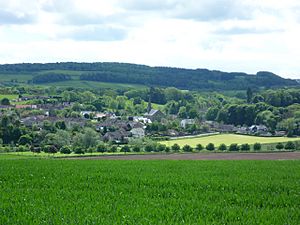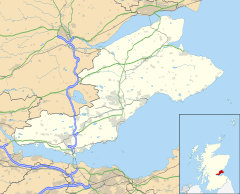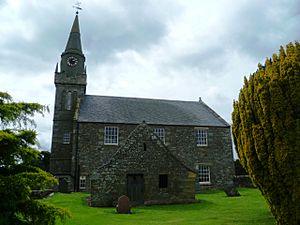Ceres, Fife facts for kids
Quick facts for kids Ceres |
|
|---|---|
 |
|
| Population | 930 (2020) |
| OS grid reference | NO400115 |
| Council area | |
| Lieutenancy area | |
| Country | Scotland |
| Sovereign state | United Kingdom |
| Post town | CUPAR |
| Postcode district | KY15 |
| Dialling code | 01334 |
| Police | Fife |
| Fire | Fife |
| Ambulance | Scottish |
| EU Parliament | Scotland |
| UK Parliament |
|
| Scottish Parliament | |
Ceres is a charming village in Fife, Scotland. It's nestled in a small valley, about 2 kilometers from Cupar and 11 kilometers from St Andrews. The area around Ceres includes smaller places like Baldinnie, Chance Inn, and Pitscottie.
Contents
What Makes Ceres Special?
Ceres is one of the few villages in Scotland that has a special open grassy area called a village green. This green is known as the "Bow Butts." Long ago, in medieval times, people used it for practicing archery. A small stream called the Ceres Burn flows through the village and along the edge of the green.
Historic Bridges and Statues
You can still see an old stone bridge, called the "Bishop's Bridge," crossing the burn. It was built in the 17th century for packhorses to cross. Near it, there's a more modern bridge for cars.
One interesting feature of the village is an 18th-century statue known as "The Provost." People think it shows a local church leader from the 1500s, Rev. Thomas Buchanan. The statue looks a bit like a toby jug, which is a type of pottery mug. This might mean the statue was a bit of a joke! The person who carved it also added a picture below the statue showing the famous Battle of Bannockburn.
Village Landmarks and History
The village is easy to spot because of its large Parish Church. Ceres is also said to have one of the shortest main streets in Scotland, with only a few houses on each side. By the Bow Butts, there's a monument that honors the men from Ceres who fought in the Battle of Bannockburn in 1314. This monument was put up in 1914, exactly 600 years after the battle.
In 1785, a famous Italian balloonist named Vincenzo Lunardi landed near Ceres after his first flight in Scotland. When he arrived in the village, people celebrated him! They carried his flag in a parade and rang the church bell.
How People Live and Work in Ceres Today
Farming is still important in Ceres. However, many people who live here now travel to work in bigger towns and cities nearby. These include Perth, Cupar, Dundee, St. Andrews, and Glenrothes. The village also has a pottery that makes traditional Fife Wemyss Ware, which is a type of decorated pottery.
The Fife Folk Museum
The Fife Folk Museum is located right in Ceres. It's housed in old buildings, including the former weigh-house. This was where grain was weighed on market days. The building also used to be a small jail for minor offenders. You can still see the village's old jougs (metal collars used for punishment) attached to the building. The museum helps us remember what rural life was like in the past. It opened in 1968 and was renovated in 2003-2004.
Where Did the Name Ceres Come From?
The name Ceres likely means "place to the west." It comes from the Scottish Gaelic word Siar, which means "west." This name probably refers to its location compared to St Andrews. You'll find other places in East Fife with names ending in -es. Some people used to think the name came from a saint, but that idea is no longer believed.
Interestingly, Ceres is also the name of the Roman goddess of farming and grain. Because of this, the village has connected with other places named Ceres, like Ceres, Italy and Ceres, Western Cape, South Africa.
Some areas around Ceres have unusual names, like Babylon and Sodom and Gomorrah. These are old names for places where there are no houses anymore. However, there's also a place called Paradise nearby, where people do live!
The Ceres Games: A Long Tradition
The Ceres Games are a very old tradition. People say they have been held every year since 1314! Robert the Bruce, a famous Scottish king, supposedly gave the village permission to hold them. This was to celebrate the men from Ceres who fought bravely in the Battle of Bannockburn. Today, these games are held as Highland games, and they are known as the oldest free games in Scotland.
The Parish Church of Ceres
The current parish church in Ceres was built in 1806. A tall tower and a pointed spire were added in the 1850s. Inside, the church still looks much like it did when it was first built. It has its original wooden box pews (enclosed seats) and a gallery.
In the church entrance, there's a very old stone statue of a knight from the medieval period. It's well-preserved and shows interesting details of armor from the 1400s.
In the churchyard, there's a special building called a mausoleum. It was built by the widow of Robert, the 9th Lord Lindsay. This vault holds the grave of John Lindsay, 20th Earl of Crawford.
Ceres Church is part of the Church of Scotland. It has joined with nearby parishes like Springfield and Kemback. Services are held in Ceres every Sunday.
The Provost Sculpture Mystery
The famous "Provost" sculpture in the village center has an interesting story. While it's said to be of Rev. Thomas Buchanan, a former minister and important church leader, parts of the sculpture are much newer. The top part looks like a "Toby Jug," which wasn't invented until after 1760. The word "PROVOST" also seems to have been added later, possibly as a joke. However, the main frame of the sculpture is indeed very old, from the 1500s or early 1600s, and shows a worn hunting scene.
Famous People from Ceres
Many notable people have connections to Ceres:
- Patrick Adamson (1537–1592), who became an Archbishop of St Andrews.
- Rev. Thomas Buchanan (died 1599), a minister of Ceres and a very important leader in the Church of Scotland.
- Sir Thomas Hope (1573–1646), a significant lawyer and statesman.
- Andrew Lemoncello (born 1982), a long-distance runner.
- James Wilson (1742–1798), one of the people who signed the United States Declaration of Independence.
Images for kids
See also
 In Spanish: Ceres (Fife) para niños
In Spanish: Ceres (Fife) para niños






